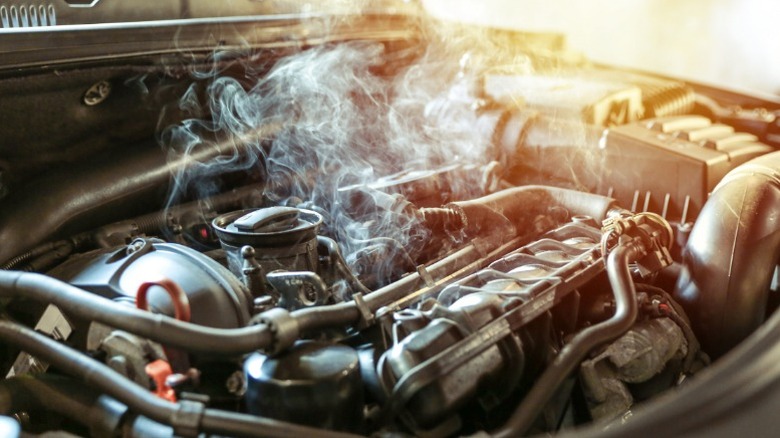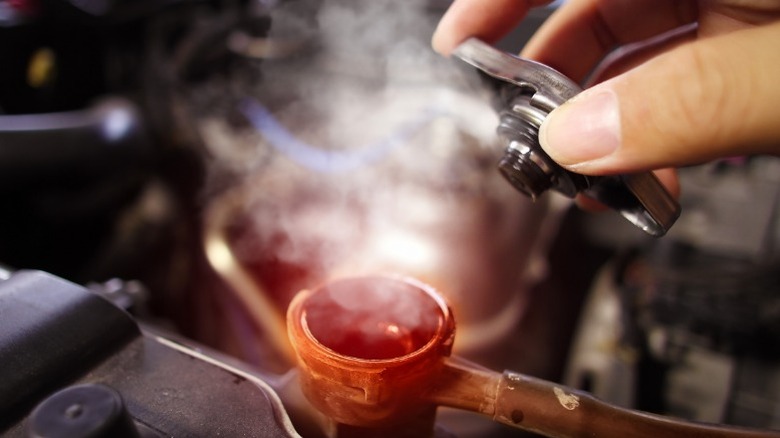Why You Should Avoid Removing The Radiator Cap On A Hot Engine
Internal combustion engines, like the ones that most modern and non-electric vehicles use, are capable of generating immense amounts of power to help us get to and from our destinations or show off at the drag strip. However, while creating all of that power, our cars' engines also get pretty hot. Heat is an expected byproduct of the internal combustion process, but extreme levels of excess heat are not normal and can cause extensive engine damage.
To help prevent the development of excess heat, automakers install dedicated engine cooling systems, which include components like the radiator, thermostat, water pump, a network of hoses and fluid passages, and coolant. Coolant is a roughly 50/50 combination of antifreeze and water, and is designed to absorb excess engine heat and carry it away from the internal parts. Most modern cars have a coolant reservoir and a radiator with a cap. And while you may be inclined — or perhaps even instructed — to pop open the radiator and fill it with water in the event of an engine overheating problem, you should avoid doing so for one primary reason.
Removing the radiator cap on a hot engine is not a smart move because it's a great way to burn yourself. Automotive cooling systems are pressurized, meaning that if you open the cap on a hot engine, coolant could shoot out, spraying you with boiling liquid and potentially causing severe burns. If your car overheats, and you're wondering what you should do instead of removing the radiator cap, stick around.
What to do if your car is overheating
If your car's engine starts overheating, you may be tempted to remove the radiator cap and try to add some water to the radiator. You may have even been taught to do so or seen someone else doing it. While adding water to a hot radiator can be beneficial, we've already covered the fact that it can also be extremely dangerous and is, in fact, something that most car owners should avoid doing whenever possible. But if you shouldn't open the radiator, what exactly should you do if your vehicle starts to overheat?
If you're cruising down the road and notice your car's dashboard temperature gauge begin to climb into the danger zone, the first thing you should do is pull over as soon as it's safe to do so. If you're in your neighborhood and extremely close to home, you can continue to your driveway. On the other hand, if you're on the highway or another road, you should pull to the side as long as it's safe. If your car's temperature gauge is in the red zone, turn the engine off and allow it to cool down for at least 15 minutes. Then, slowly and safely make your way to a mechanic's shop for an inspection or your home, where you can inspect the coolant level yourself before proceeding. Alternatively, you may want to consider calling a tow truck, especially if you're far from home. Severe overheating can cause smoke or steam to billow out of your engine bay. This is most likely just coolant boiling. However, if you see flames or smell burning rubber, you should contact emergency authorities for help.
What else should you avoid doing to a hot engine?
Removing the radiator cap isn't the only thing you should avoid doing to a hot engine. While it may seem obvious that you shouldn't mess with extremely hot engine parts, many people aren't aware of just how warm these components get, and most of us probably know someone who has burned a finger or two touching something they shouldn't have touched. For that reason, it's smart to familiarize yourself with your vehicle's engine bay and the parts that you should avoid while the car is hot. It's also worth learning about the components that you can and, often, should handle when the engine is hot.
First, you should avoid touching anything metal. That includes things like the exhaust manifold, hose fittings, the engine block, and any other metal component. You should also avoid opening fluid reservoirs or fill points, like the coolant reservoir and the engine fill cap. While it's unlikely that fluid will shoot out of other reservoirs in the way that coolant can explode out of a hot radiator, it still increases the risk of burns. That also means you shouldn't replace these fluids while the engine is extremely hot, either. You can perform these jobs when the engine is warm — in fact, doing so can be beneficial at times. However, if you're inexperienced, you should allow the engine to cool off completely before performing DIY auto jobs.
That said, there are some things that you should do while the engine is warm and running. For example, you should check your transmission fluid with the engine running and at operating temperature. The engine must be running for various other forms of inspection work. However, remember to avoid touching the parts mentioned above to prevent injury.


